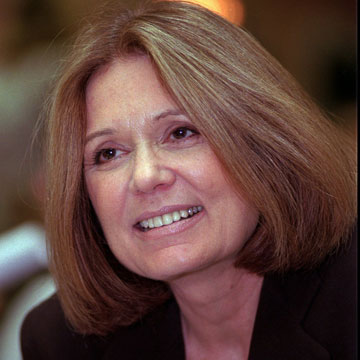
Feminist icon Gloria Steinem, founder of Ms. Magazine, photographed Sept. 25, 1997 (AP /Robert F. Bukaty)
The following has been excerpted with permission from the essay “Revaluing Economics” in Gloria Steinem’s 1994 book Moving Beyond Words.
Labor costs didn’t always reflect the country’s values — as imperfect as they may be. Child care attendants were paid less than parking lot attendants, and nurses’ aides often got less than the men who picked up garbage at their hospitals — not because we were consciously valuing our children less than our cars, or patients less than garbage. The truth was (and still is) that in the United States, as in almost every country, categories of work are less likely to be paid by the expertise they require — or even by importance to the community or to the often mythical free market — than by the sex, race and class of most of their workers. This becomes clear when similar work by different groups of workers is compared within countries. Women in the United States might be poorly paid “office cleaning women” who do the same job that men do as better-paid “janitors” or even “maintenance engineers,” and men who wouldn’t dream of being typists might now be “keyboard literate” information processors of the computer age, who are paid more than secretaries doing the same task. It is also evident when the same categories of work are compared among countries. Road building might be well paid here and in Canada, where it’s done by men, but poorly paid in other countries, from vast Russia to tiny Nepal, where women do it. In Japan, electronics assembly is done primarily by men and is decently paid, while in Hungary and Mexico, it’s the province of women who get poor pay and working conditions. In Turkey, tobacco processing is low-status “women’s work,” but in the United States, it’s romanticized by cigarette ads and tradition as “men’s work” — and is better paid. A cheap labor force cheapens whatever it does — until it rebels.
This wage fixing by cultural caste system is at least as effective as any conspiratorial price fixing for which businesses are legally prosecuted, and sometimes as conscious — as when 9to5, the clerical workers’ union, discovered that insurance companies in Boston were fixing the range of clerical salaries in the guise of information sharing. The free market has little to do with it. There is no shortage of nurses in this country, for instance, only a shortage of wages and respect that drives nurses into other professions. Instead of raised salaries, this dilemma has often been met with attempts to change training requirements and import nurse from other countries. When nurses’ unions fight lowered salaries on everyone’s behalf, they are said to be opposing immigrant women. Imagine the response if car makers lowered salaries and standards for the much less skilled but mostly white male work on assembly lines, and tried to import workers from other countries.
Though the first few women in a male field may benefit from its higher pay and status, it’s as temporary as the values in a white neighborhood where the first “minority” families buy houses at prices at least as high as white families, but may lose investment value as white families leave. Indeed, even for female tokens in prestigious male fields, the salaries aren’t yet equal. According to the January 1994 salary survey of Working Woman magazine, male engineers get $11,000 a year more than female engineers, and women corporate vice presidents get only about 57 percent of the salary level of their male counterparts. Once any field includes “too many” women (usually when females become about a third of the whole), it is devalued, just as is the neighborhood into which “too many” families of the “wrong” race have moved, and for the same reasons — exclusivity and bias. Thus, bookkeeping in this country was fairly well paid while it was a male occupation but became devalued once women gained entry in large numbers. Men invented “certified public accountant,” and moved on due to a certification process that first excluded women of all races (the American Institute of Certified Public Accountants had a “no women” policy into the 1950s), and then required experience at public accounting firms that rarely hired anyone other than white males. That remained true until recent social justice movements forced the issue. In managerial and professional jobs in general, an Urban League study from the late 1980s predicted the percentage of blacks and whites is unlikely to narrow significantly before the year 2039, and even if that happened, salary parity for black and white men wouldn’t arrive before 2058; such is the depth of workplace racial segregation.
Whether in the United States or in the international economy, it’s a rule with few exceptions: Work is valued by the social value of the worker. A category of work is paid least when women do it, some what more when almost any variety of men do it, and much more when men of the “right” race or class do it.

